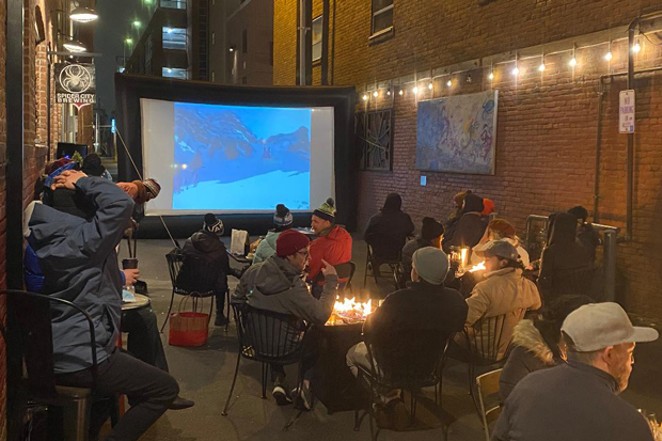COVID-19 affected everyone, human and business alike, completely differently. Bend institutions like Sargent's Cafe and Pilot Butte Drive-In didn't survive the virus, while newer spots like San Simon managed to pivot and thrive. It became almost impossible to predict which businesses would make it through the toughest and scariest time many of us could possibly imagine.
I wouldn't have blamed you if you didn't bet on Tin Pan Theater making it through the pandemic. The 29-seat arthouse cinema (now owned and operated by BendFilm) was already one of the two or three smallest movie theaters in Oregon, and in a time where the once-mighty Redmond Cinema closed its doors forever and streaming from home became bigger than ever, Tin Pan managed to keep the lights on, even after shutting down indoor screenings for close to 15 months.
I asked a few of the managers of Tin Pan (where I serve as programming manager and resident handsome bastard, if I don't say so myself) what they did specifically to keep Bend's beloved arthouse alive. Here is a lightly edited look at their answers.
Source Weekly: Are there lessons you learned about operating the theater during COVID that you will carry over to running the theater post-COVID?
General Manager Julie Furnas: I quickly learned the difference between cleaning, sanitizing and disinfecting. All are important, BUT disinfecting is THE most important thing you can do to keep areas extra safe!
BendFilm Executive Director Todd Looby: Operating the theater and BendFilm during this time only underscored and reinforces things we already knew or suspected: That if you as an arts organization or business are pivoting, inventing and improvising with enthusiasm and purpose, that the audience will respond in overwhelmingly positive ways. The thing that is often undervalued or not fully understood, but should never be, is that arts nonprofits provide a direct service that is incredibly important—especially in confusing, difficult and contentious times. And that direct service is one to our emotions. Many people suffered directly from COVID via the loss of health or of loved ones; many people lost jobs and careers, and many were incredibly lonely. What we heard time and time again over the past 15 months is that our efforts to bring people together safely, in the Alley, in the theater, at the drive-in, in online discussions, even our communications and blogs about things to look forward to had an incredibly powerful impact. If there are no organizations specifically catering to bringing people together and stoking positivity, our community can be so easily siloed by other forces with more resources than us. But, gladly, our audience and supporters have been very clear that they back and support our efforts to counter those divisive forces, and luckily, it's really fun to do—especially with the great board, staff and community we have.
SW: What were some of the unique challenges in keeping Tin Pan alive during the pandemic?
Screening and Tech Manager Todd Leiser: Reaching out to our audience and trying to figure out how to best keep them engaged in ways that they felt most comfortable was one of the most unique challenges. The most significant adaptation was the move to outdoor screenings in the alleyway. Figuring out the best things to play outside and keeping our loyal patrons interested in continuing to return to Tin Pan has been an ongoing puzzle to solve.
SW: Was it more difficult to close when you did or to decide to reopen when you did?
Looby: I wouldn't say either was particularly difficult. We were the first theater to close in town because we knew if we were to remain open, our audience and staff would be at unnecessary risk. We were very thoughtful about reopening but finding good films at that point was the only challenging aspect because, understandably, filmmakers and distributors were still trying to figure out their best strategies to make sure these great films got their due either online or in a theater.
SW: What can film fans do to keep Tin Pan thriving?
Furnas: Continue to bring friends, families and our community together to experience films in a very unique way. We are SO thankful for everyone who has supported BendFilm and the Tin Pan during our darkest days. We love you and can't wait to see you back in our seats.
Leiser: Check our schedule every week and come and see any film that piques your interest. If you can't come see a film, give us a donation! Also tell your friends about us. There are a lot of people who don't know that Tin Pan exists or that we are the one indie arthouse cinema in Bend. The more people know, the more they will come out.
SW: Are you already noticing differences in how audiences are since reopening?
Furnas: Some people have become extra cautious, which I believe makes other people uncomfortable. We didn't think and talk about viruses, vaccines and politics 20 years ago like we do now. The world as it was has changed forever and I think it includes how we watch movies. With new home technology and streaming services that came about during the pandemic, some people may never come to a movie theater again.
Looby: Audiences are tentative and skewing younger than normal, but they are all overwhelmingly happy to be back in a movie theater.
Tin Pan Theater
869 NW Tin Pan Alley, Bend
Tinpantheater.com























